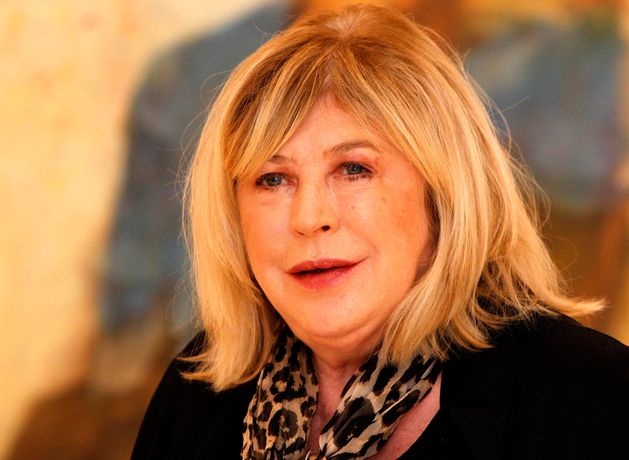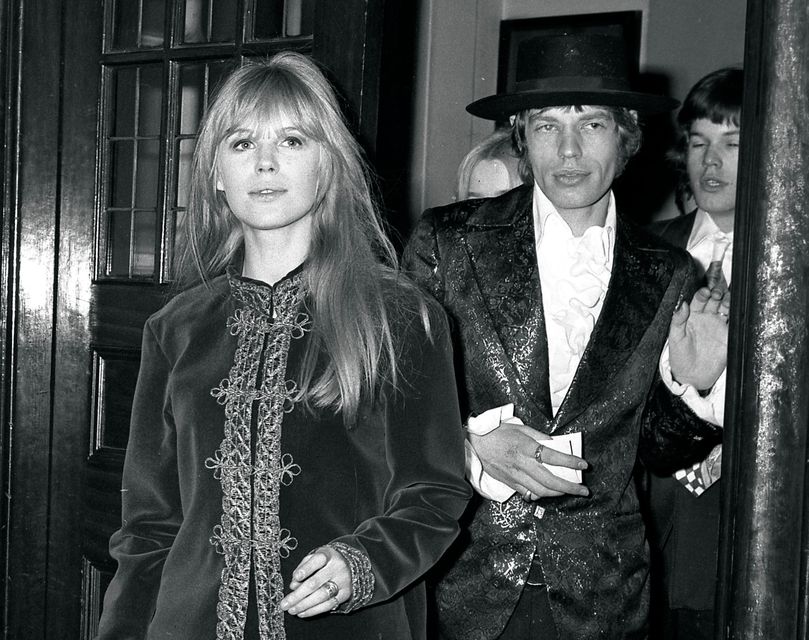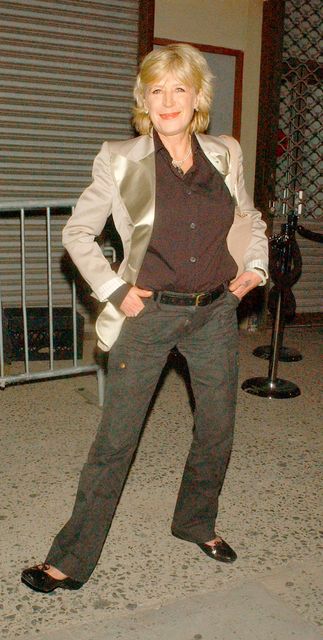“When I was about 15, before it all happened,” she said. “I was happy, with my mum, with my school friends, really innocent. I mean, the naughtiest thing I did was reading Oscar Wilde and Baudelaire.”
The less happy — and naughtier — time she was alluding to started when she was 16 and met Mick Jagger, frontman with the Rolling Stones. They became the golden couple of London’s Swinging Sixties.
The original It Girl, photographed everywhere she went, Faithfull was an icon of glamour and angelic innocence. But in time she came to epitomise rock’n’roll self-destruction.
She became a homeless heroin addict in Soho. Weighing barely six stone, she lost two teeth in a fight over drugs. She also lost custody of her son. She was penniless, getting a daily dose of methadone on an NHS programme. It was the opposite of her previous fashionable existence on the arm of Jagger.
Yet she said the truths she learned among the down-and-outs had far deeper meaning for her.
“I’d been living in a very fake sort of world in the 1960s,” she once said. “Suddenly, when I was living on the streets, I realised that human beings were really good. The Chinese restaurant let me wash my clothes there. The man who had the tea stall gave me cups of tea.”
It was not how you’d expect the convent-educated girl whose ancestors were Austro-Hungarian aristocrats to turn out.
Born in Hampstead on December 29, 1946, Marianne Evelyn Gabriel Faithfull was the daughter of Major Glyn Faithfull. Her mother, Eva Hermine von Sacher-Masoch, was a Viennese baroness. Marianne’s great grand-uncle was Leopold von Sacher-Masoch, who wrote the literary homage to sadomasochism, Venus in Furs.
Faithfull with Mick Jagger in 1967. Photo: Getty
Marianne’s early childhood was spent at Braziers Park, a commune in a 17th-century country house in Oxfordshire that her father was involved in, which she later described as a “mixture of high utopian thoughts and randy sex”. When she was six, her parents divorced and she moved to a terraced house in Reading with her mother. She was raised like “one of her mother’s cats”.
She attended St Joseph’s Convent School, a Catholic boarding school, though her father counselled against it on the basis that the nuns would “give her a problem with sex for the rest of her life”.
Be that as it may, in school she started singing and exploring the nightclubs of London. In 1964, Stones manager Andrew Loog Oldham spotted her at a party.
“He asked me, ‘Can you sing?’ And I said, ‘Mm-mm, I can’. About a week later, I got a telegram from Andrew, saying, ‘Be at Olympic Studios at 2 o’clock’.”
Jagger and Keith Richards wrote a song for her, As Tears Go By. It made her a pop star — and she was soon a married pop star, when on May 6, 1965, she married artist John Dunbar, owner of The Beatles’ favourite gallery, Indica. The following year, on November 10, she gave birth to their son, Nicholas. Not long after, she left Dunbar and stayed with Stones guitarist Brian Jones and his girlfriend, Anita Pallenberg.
She slept with Jones and then with Richards before settling on Jagger. As she put it: “I slept with three and decided the lead singer was the best bet.”
I’m a textbook case. I started smoking hash and within two or three years I was on heroin
But the influence of the Stones’ narcotic orbit was obvious.
“I’m a textbook case,” she once said. “I started smoking hash and within two or three years I was on heroin.”
In 1967, she became the victim of salacious infamy when the News of the World and other newspapers eviscerated her character after Keith Richards’ home, Redlands, in Sussex, was raided by police after a tip-off that a drugs orgy was taking place.
Richards and Jagger were arrested for drugs, and Faithfull was reportedly found naked, wrapped in a fur rug, with a well-known chocolate bar on her person. “Naked Girl at Stones Party” read the headline.
She would later speak of the misogyny the incident embodied.
“It destroyed me,” she said. “To be a male drug addict and to act like that is always enhancing and glamorising. A woman in that situation becomes a slut and a bad mother.”
In 1969 in Australia, where Jagger in the title role was filming Ned Kelly, she took more than 100 pills of the barbiturate Tuinal and was in a coma in hospital for six days.
“It’s very bad form to try and kill yourself when you’re with Mick Jagger,” she said with characteristic gallows humour. Coming out of the coma, she told Jagger: “Wild horses couldn’t drag me away.”
Marianne Faithfull in 2002. Photo: Getty
The line inspired one of the Stones’ most famous songs, Wild Horses. It was not the first time she had been Jagger’s muse. She gave him the novel The Master and Margarita, by Mikhail Bulgakov, which inspired Sympathy For The Devil. There was more. You Can’t Always Get What You Want was inspired by her; more controversially, Sister Morphine, a solo single for Faithfull in 1969 (two years before the Stones’ version appeared on the Sticky Fingers LP), was a co-write with Jagger and Richards. However, it wasn’t until 1994, after she took the Stones to court, that she was given a songwriting credit on the Stones’ album.
Their relationship never recovered from Faithfull’s suicide attempt.
“I just wanted out of that world,” she said. “It wasn’t that I didn’t love Mick, but I wasn’t cut out for all that. It’s a great honour to be a muse, but that’s a very hard job.”
On another occasion she said of Jagger: “I wanted to be a junkie more than I wanted to be with him. That was my idea of glamour. There was something wrong with me from my childhood and I don’t really know why, and there we are. Heroin was like being wrapped in pink cotton wool.”
In 1973, she wore a nun’s habit to duet with David Bowie on I Got You Babe for an American TV show. Bowie wrote in his book Moonage Daydream: “Because of her convent background, I felt Marianne would carry the moment superbly as a nun — albeit without a back panel to her habit, revealing her splendid arse. Not shown on the telly, natch.”
It was sheer vanity. I couldn’t bear the thought of being found dead upside down in red fishnets
In 1975, she released the Dreamin’ My Dreams album. Four years later came Broken English, when she sang about her druggy fall from grace, as well as German female terrorist Ulrike Meinhof on the title track. It earned her a Grammy nomination for female rock vocal performance.
She won the kind of edgy new wave credibility Jagger could only dream of with his band of multimillionaires. Sex Pistols manager Malcolm McLaren even tried to cast her as Sid Vicious’s junkie mother in The Great Rock’n’Roll Swindle movie.
Over the next four decades, the long-since-drug-free Faithfull collaborated with Metallica, PJ Harvey, Nick Cave, Blur, Beck and Pulp. Her last album, in 2021, She Walks in Beauty, saw her reciting the poetry of Keats, Shelley and Wordsworth.
Her cultural status as icon was confirmed when she was cast as God (opposite Pallenberg as the Devil) in Absolutely Fabulous, and as Empress Maria Theresa in Sofia Coppola’s movie Marie Antoinette.
She lived for a time in Waterford, Kildare and then Dublin. I met her a few times and in the mid-1990s visited her in hospital when she was ill.
In 2000, after dinner in Wicklow with actor Daniel Day-Lewis and his wife Rebecca Miller, she fell down the stairs. She managed to turn her body as she fell and landed on her shoulder.
“It was sheer vanity,” she said. “I couldn’t bear the thought of being found dead upside down in red fishnets.”
Who was Marianne Faithfull? I think she summed herself up best: “I am a fabulous beast, and as such, I should only be glimpsed very rarely, through the forest, running away for dear life.”





